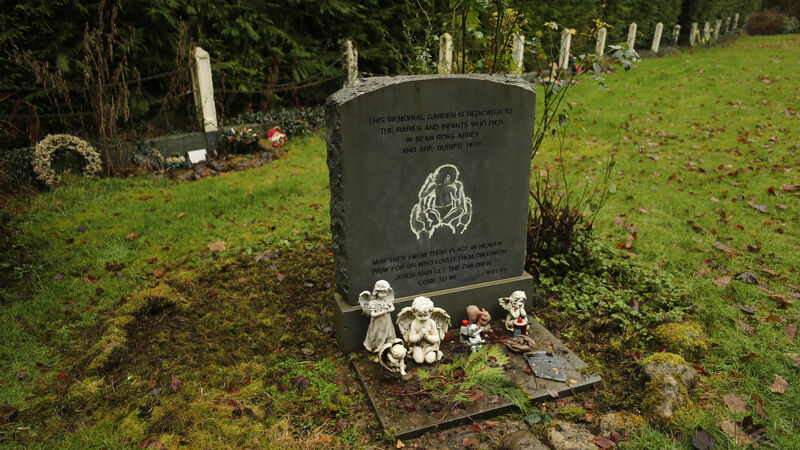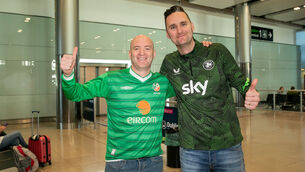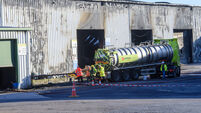Some 15% of children who passed through doors of mother and baby homes died

The infants' graveyard at Seán Ross Abbey in Roscrea, Tipperary, a mother and baby home operated by the Sisters of the Sacred Hearts of Jesus and Mary from 1930 to 1970.
The commission of investigation found around 9,000 children died in mother and baby homes —about 15% of all the children who passed through their doors.
The report says the very high mortality rates in homes in general were known to local and national authorities at the time and were recorded in official publications.
“The very high rate of infant mortality in Irish mother and baby homes is probably the most disquieting feature of these institutions,” the commission said.
“The death rate among ‘illegitimate’ children was always considerably higher than that among ‘legitimate’ children. But it was higher still in mother and baby homes.”
It said that, for example, the death rate among infants in mother and baby homes was almost twice that of the national average for ‘illegitimate’ children in the years 1945 to 1946.
Attempts to deal with the rising death rates could be met with resistance.
When, for example, government inspectors were becoming concerned about the wellbeing of children born to private patients in Bessborough, they were met with a blank wall when trying to find out why.
When there was an attempt to have the mother superior in charge in Bessborough in the 1940s removed because of the “appallingly-high death rate”, the request was “denounced” by the Bishop of Cork, Dr Daniel Cohalan.
The commission noted: “The replacement of the Bessborough superior was delayed for four years after the [request]. Many infants died during that time.
“It seems probable that the bishop’s intervention was elicited by the congregation.”
The report highlights that “no publicity” was given to the fact that in some years during the 1930s and 1940s, over 40% of ‘illegitimate’ children were dying before their first birthday in mother and baby homes.
“The children of Irish unmarried mothers were hidden from the public gaze,” the commission said.
“Infant mortality in general remained high in Ireland until the late 1940s, especially in the inner cities, yet there was no national outcry about this, except among a small number of medical professionals.”
By far the worst institution in terms of the highest number of deaths was St Patrick’s on the Navan Rd, Dublin. Formerly known as Pelletstown, some 3,615 children died. Most of the deaths occurred between 1920 and 1942.
Another 923 children who were associated with Bessborough Mother and Baby Home in Cork died. According to the commission, it had the highest recorded infant mortality rate among mother and baby homes in 1934.
Infant mortality reached even higher levels in the early 1940s.
In St Mary’s Mother and Baby Home site in Tuam, some 978 children died, with the overwhelming majority of them being aged under a year.
While the numbers of death in the home in Kilrush, Co Clare, is unknown, the commission noted “the medical officer described the death rate in 1927 as appalling”.
Although only 9% of the babies were the children of private patients, they accounted for 21% of deaths.
Bessborough failed to keep a register of infant burials and the burial location of the majority of children who died there is still unknown.
Like Bessborough, Seán Ross Abbey in Roscrea was owned and run by the Congregation of the Sacred Hearts of Jesus and Mary.
There were a total of 1,090 of the 6,079 babies, who were born or admitted to the hospital. About 79% of the deaths occurred between the years 1932 and 1947. The worst years were 1936 and 1942.
Within just two years of Seán Ross opening, the congregation acknowledged that there was a ‘problem’ with the high rate of infant mortality, and they sent a sister from Liverpool to investigate the cause.
Registers of burials were not maintained, the commission noted. There is a designated burial ground and the commission has established that “the coffined remains of some children under the age of one” are buried there.
The commission briefly touches on the issue of where mothers and children were buried.
While not every institution buried their dead on-site, some homes were singled out for comment. Bessborough is one.
The commission remains perplexed and concerned at the inability of any member of the Congregation of the Sacred Hearts of Jesus and Mary to identify the burial place of the children who died in Bessborough.
“The concern of the congregation about marking the graves of the children who died in Castlepollard does not seem to have applied to the children who died in Bessborough.”
In looking into the causes of deaths, the commission noted the term “marasmus” — a form of starvation — was a common cause until the 1940s.
From the 1950s, it was not generally accepted as a cause.
The commission notes: “Some commentators have concluded that infant deaths which occurred in mother and baby homes due to marasmus indicates that infants were neglected, not appropriately cared for, or starved to death in these institutions.
“However, marasmus was a frequently cited cause of infant deaths in institutional, hospital and community settings in early 20th-century Ireland. The commission considers it unlikely that deaths in hospitals and family homes were due to willful neglect and so cannot conclude that the term marasmus denotes wilful neglect in mother and baby homes.
“The more likely explanation is that marasmus as a cause of death was cited when an infant failed to thrive due to malabsorption of essential nutrients due to an underlying, undiagnosed medical condition.”









